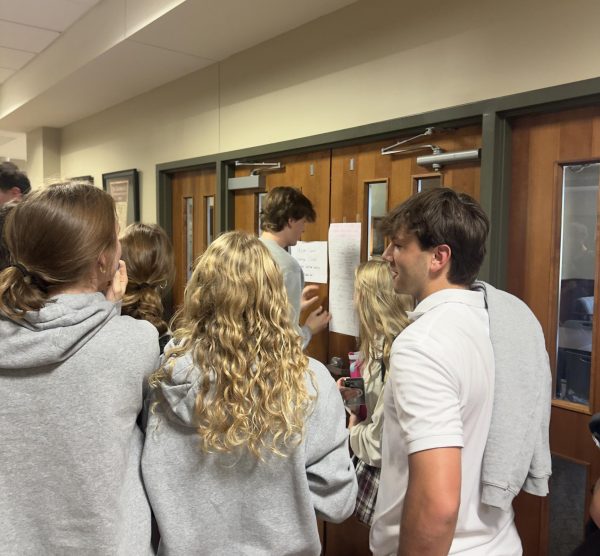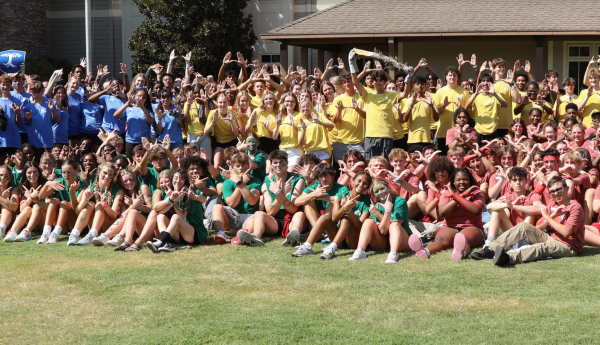Turn Back Time
New schedule gets mixed reviews
Junior Mariah Nellessen has experienced a different schedule for each of the past four years. In fact, anyone who has been attending St. George’s for that long has.
In 2018-19, the schedule had three periods before lunch, a 50-minute lunch block, a fourth period, and then x-block from 2:30-3:15. But all that ended in March of 2020, when the school went remote and students attended class in 30-minute blocks, with 30 minutes in between.
Students and teachers alike were left questioning the reasons behind these changes. Last year, while the school faced extensive COVID protocols and a learning plan that had students in person and online, active teaching lasted 50 minutes with 20 minutes at the end of class for study time.
This year there are two periods before lunch, the second period being nearly two hours long, a 45-minute lunch block and two more periods concluding the day.
Ms. Pam McCarthy, director of the upper school, stressed that the changes made to the schedule were in response to the pandemic.
“In the 2020-2021 school year we created a new schedule for COVID specifically to make sure we were following all of the protocols,” she said. “If 2020 COVID didn’t happen, I don’t think our schedule would’ve changed. I don’t think the schedule we had before was broken.”
According to students, the most significant change was the shift from x-block to extended block.
The extended block, which takes place during the second period of each day replaced a 45-minute period at the end of the day, that was known as “x-block.”
Nellessen was not happy with the change.
“My first thought when I found out about the extended block was ‘What happened to x-block?’,” Nellessen said, “and it made me very upset.”
“One of the reasons why this was a better school for me was because they had x-block at the end of the day,” she said. “It was just a great time to meet with all your teachers and go to any teachers you needed help with or work on a project with a group.”
Junior Angelina David, also misses the x-block. Last year, when she was planning her schedule for this year, she decided to take seven classes, one for every available period, and to not take a study hall. She made this decision before she was aware that x-block wasn’t coming back.
“X-block was a thing where I could be like, ‘I can not have a study hall and still keep my sanity and keep my grades where they need to be’,” she said. “Without that, it’s extremely stressful.”
Junior Reese Dlabach, a member of student government, said the new extended block isn’t a good replacement for the lost time.
“Some teachers teach into the extended block, and since there isn’t an x-block or the built in 20 minutes like there was last year, there isn’t always time for students to get work done when they have sports after school,” she said. “It makes it more stressful that there isn’t time to do work in school.”
According to Ms. McCarthy, the x-block had some negative aspects too.
“X-block as an academic period was based on feedback from students and teachers and families,” she said. “It worked in some situations, but there was a lot of what people called dead time. Kids were scrolling on phones and just sort of zombie-like. Those weren’t my words, so someone actually said that.”
While the schedule was being created, Ms. McCarthy said the safety of the staff and students was a top priority.
“We were trying to think about how we can still adhere to our COVID protocol while making a more productive school day for our students,” she said.
Even though the point of the extended block was a more productive day, it is getting some negative reviews from teachers and students.
Nellessen said she finds it tiring when teachers teach through the extended block.
“There are the teachers that do teach for two full hours, and it actually breaks my mind. Like, it gives me a headache,” Nellessen said.
Freshman Lorelai Michael also noted how an extra 45 minutes in a classroom can be a lot to handle.
“I think it works for some classes and not for others,” she said. “My brain cannot function for the rest of that two hours of learning more academic work, but for other classes where we do something different besides the regular class-work, where we do a little extra something that works on those skills [that can be okay].”
Students are not the only ones who see the difficulties of staying engaged for the entire extended period. Ms. Emily Metz, history and AP government teacher, said that she understands the challenges of the extended block for students.
“I am giving my kids a 45-minute study hall at the end of that time,” she said. “I don’t have the stamina to teach for that long. If I don’t have that kind of stamina, I worry that my students also don’t have that kind of stamina. For now I’m just giving them the opportunity to work ahead on projects and homework or stuff they need to get done for their classes.”
Chemistry teacher Mr. Ethan Sullivan also struggled to stay occupied during the extended block.“It’s just a long time to be in a classroom, and if you have something you can do that’s productive outside that’s great, but maybe you don’t,” he said.
As a lab science teacher Mr. Sullivan said he could see benefits as well.
“There are some times as a lab science teacher I can definitely use it, and it will make my life a lot easier,” he says. “I have five lab stations. If I have a class of 20, that would mean four kids per station, which is probably not optimal right now, so I can use that time to have two kids per lab station, and then have people cycle through.”
Some students also saw some positives of the extended block.
“I think an upside is that if ]you’re in a class that you need help with, it gives you time to ask the teacher a question,” Dlabach said.
Though the extended block remains in place for now, it may not stay after the pandemic is over.
“I don’t know that our intention was ever to keep this schedule forever,” McCarthy said.







